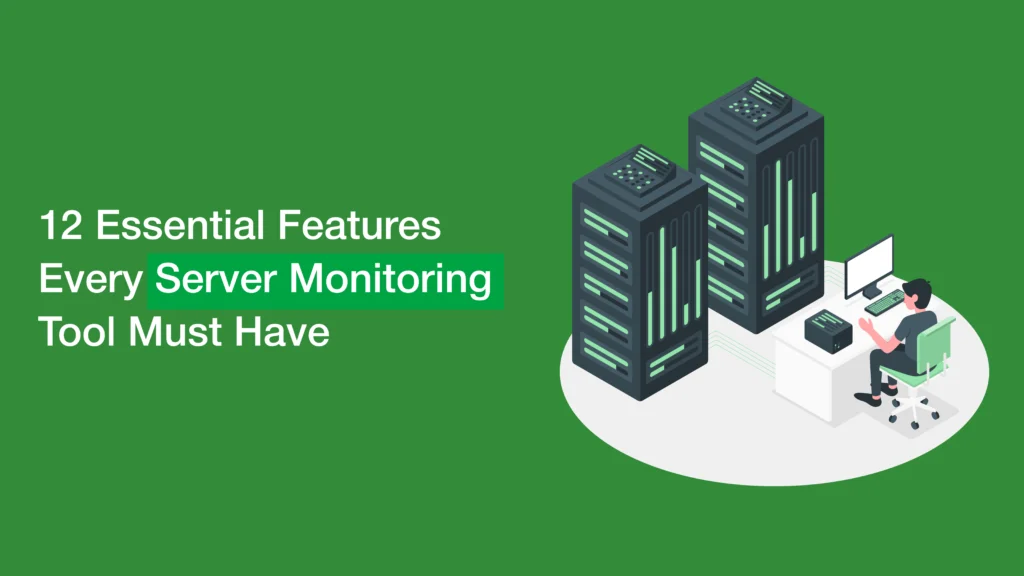
- July 2, 2025
- Abiya A
- 10:00 am
Choosing the Right Server Monitoring Tool: 12 Features That Matter Most
In a world where users expect instant access, every millisecond of server downtime matters. Whether you’re part of a lean DevOps team or managing enterprise-scale infrastructure, choosing the right server monitoring tool could be the smartest decision you make this year.
But what makes a tool right for your environment? We’ve broken it down into the 12 features you can’t afford to ignore—backed by real-world needs, not marketing fluff.
What Is a Server Monitoring Tool (and Why It’s a Must-Have)?
If you’ve ever had to troubleshoot a sluggish site, a CPU spike, or an unexpected outage at 2 AM, you already know the answer.
A server monitoring tool helps you track server health, performance, and uptime in real time. But more than that—it gives your team the visibility and control they need to act before problems escalate.
1. Real-Time Server Monitoring
Monitoring without real-time data is just guesswork. When systems start misbehaving, you need to know right now, not after the damage is done.
Real-time server monitoring means you’re seeing live insights—CPU usage, memory overloads, traffic spikes—as they happen.
2. Server Performance Metrics That Make Sense
Let’s be honest: staring at raw logs is exhausting. A great tool should visualize key server performance monitoring metrics like:
- CPU load
- Memory usage
- Disk I/O
- Network latency
At Kllyroo, you’ll find customizable dashboards that actually make sense—so even at a glance, you know where things stand.
3. Smart Alerts, Not Just More Noise
What’s worse than no alerts? A flood of irrelevant ones. Your monitoring tool should alert you only when it matters.
Kllyroo’s smart alerting system cuts through the noise, prioritizing based on severity and letting you route them to Slack, Teams, or email.
4. Uptime Monitoring That’s Always Watching
If uptime is your SLA, monitoring it is your insurance policy. Your tool should run background checks on all your critical services—24/7—reporting availability and downtime in real time.
5. Historical Trends & Patterns
Knowing what happened is one thing. Knowing how often it happens? That’s real power.
With built-in trend analysis, you can identify recurring bottlenecks and preempt them.
6. Resource Usage Reporting That Actually Helps
When servers lag, it’s often a capacity issue. A capable monitoring solution shows you who (or what) is hogging your resources—CPU, RAM, or bandwidth—before downtime hits.
7. Root Cause Analysis Without the Manual Digging
Fixing the symptoms is quick. Fixing the cause? That’s smart. Your tool should help you trace problems back to their source: bad deploys, faulty scripts, or rogue processes.
8. Designed to Scale With You
Whether you’re monitoring 5 servers or 500, your tool should grow with you.
Kllyroo is built for scale—from startups to enterprises, hybrid to multi-cloud.
9. Thresholds You Can Actually Control
Every environment is different. You should be able to set thresholds based on your actual load patterns—not some arbitrary default.
10. Works Across Platforms
Whether you’re running Linux, Windows, or a hybrid environment with AWS and Azure, your monitoring should cover all of it—without juggling tools.
11. Plays Well With Your Stack
Already using Slack, Jira, PagerDuty, or Prometheus? Great. Kllyroo integrates easily with your existing DevOps toolkit—because new tools should reduce complexity, not add to it.
12. Security & Role-Based Access
Your monitoring dashboard holds sensitive data. Role-based access, audit logs, and encrypted data handling aren’t extras—they’re essentials.
Feature Snapshot: What to Look For
Must-Have Feature | Why It Matters |
Real-time Monitoring | Detect issues instantly |
Server Performance Metrics | Diagnose problems faster |
Smart Alerting | Reduce alert fatigue |
Uptime Tracking | Ensure consistent service |
RCA & Integrations | Faster resolution, seamless workflows |
Why It All Matters: Your Infrastructure Deserves Better
The purpose of a monitoring and management server isn’t just to gather data—it’s to make data actionable. And the best server monitoring tools for DevOps don’t just tell you what’s broken; they help you fix it faster.
At Kllyroo, we’ve built a monitoring platform for teams that can’t afford to slow down. It’s lightweight, real-time, and actually enjoyable to use.
Final Thoughts
If you’re still running blind—or worse, reacting too late—maybe it’s time for a change.
Kllyroo gives you clarity, speed, and control over your servers—without the bloat.
Try Kllyroo for free and monitor what matters.
FAQ
To keep your servers healthy, your infrastructure reliable, and your teams informed—before things break, not after.
The best one is the one that fits your team, your stack, and your goals. Kllyroo is built for modern DevOps workflows, so it’s lightweight, fast, and incredibly easy to adopt.
By alerting your team instantly when performance issues arise, real-time server monitoring helps you respond before users are impacted—minimizing downtime.
